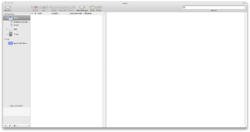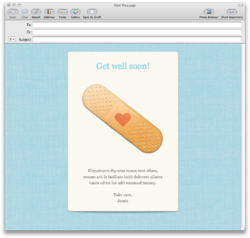- Mail (application)
-
Mail 

Mail 5.0 under Mac OS X LionDeveloper(s) Apple Inc. Stable release 5.1 (1251/1251.1) / October 12, 2011 Operating system Mac OS X and iOS (Apple) (Mobile) Type E-mail client License Proprietary Website [1] "AppleMail" redirects here. For the System 7 software of that name, see PowerTalk.Mail (aka Mail.app or Apple Mail) is an e-mail program included with Apple Inc.'s Mac OS X operating system. Originally developed by NeXT as NeXTMail, a part of their NeXTSTEP operating system, it was adapted, following Apple's acquisition of NeXT, to become OS X's Mail application. Mail uses the SMTP, POP3, and IMAP protocols, and supports Yahoo! Mail, AOL Mail, Gmail, MobileMe and Exchange via IMAP. iOS features a mobile version of Apple Mail with added ActiveSync support. Starting with the version shipped with Mac OS X v10.6, Mail has Microsoft Exchange Server 2007 support using Exchange Web Services.
Contents
History
Mail's first incarnation was as NeXTMail, the mail application for the NeXTSTEP operating system. NeXTMail was innovative for its time, supporting rich text formatting with images, and voice messaging. It also supported MIME emails, along with plain text, to allow for backward compatibility. The default message found in the inbox when the user first opened NeXTMail included a voice recording of Steve Jobs.
When Apple began to adapt NeXTSTEP to become Mac OS X, both the operating system and the application went through various stages as it was developed. In a beta version of OS X, known as the code-name "Rhapsody", and various other early pre-releases of Mac OS X, Mail was known as MailViewer. However, with the third developer release of Mac OS X, the application had returned to being simply known as Mail.
Version 1
Included in all versions of Mac OS X up to and including Mac OS X v10.3, Mail was integrated with other Apple applications such as Address Book, iChat, and iCal. Some of its features that remain in the most recent version of Mail include rules for mailboxes, junk mail filtering and multiple account management.
Version 2
Included with Mac OS X v10.4 "Tiger" on April 29, 2005, updates to Version 2 included a proprietary single message-per-file format (with filename extension .emlx) in order to permit indexing by Spotlight.
Some of the new features in Version 2 also included:
- "Smart mailboxes" using Spotlight technology to sort mail into folders.
- The ability to flag messages with a low, normal or high priority and to use these priorities in mail rules and smart mailboxes.
- Tools for resizing photos before they are sent (to avoid too-big e-mail attachments).
- The ability to view e-mailed pictures as a full-screen slideshow.
- Parental controls to specify who is allowed to send e-mail to children.
- HTML message composition.
The new version also changed the UI for the buttons in the toolbar. Where previous buttons had free-standing defined shapes, the new buttons had shapes within a lozenge-shaped capsule.[1] According to many users, and even Apple's own human interface guidelines at the time, this was worse for usability.[2] An open-source third-party application reverted Mail to use the old icons.[3] Nevertheless, Apple updated their guidelines to include capsule buttons, and the new UI has persisted.[4]
Version 3
Introduced with Mac OS X v10.5 Leopard,[5] Version 3 included personalized stationery which is handled in standard HTML format. Mail 3 also offered Notes and To-dos which can be synced with iCal as well as a built-in RSS reader. Mail 3 also introduced IMAP IDLE support (only for inbox, not for folders).
Version 4
Introduced with Mac OS X v10.6 Snow Leopard.[6] The new version of Mail gained Microsoft Exchange Server 2007 support. The iCal and Address Book applications also have support for Microsoft Exchange Server.[7]
Version 5
Introduced with Mac OS X v10.7 Lion. Mail 5 features a redesigned iPad-like fullscreen UI, a more powerful search engine, and support for Microsoft Exchange Server 2010 and IMAP Yahoo Mail. It also groups messages from the same conversation and displays them in a streamlined feed, like in Mail on iOS 4.[8] The bounce function, where unwanted emails can be bounced back to the sender, was dropped for no apparent reason.
Plain text format when message is sent
Mail has a unique feature in which messages are automatically sent in plain text format unless action is taken to format the e-mail with rich text editing options. This aspect of Mail can be misleading because the selected default font for new messages is not what will show up on the recipient's side unless there is a manually-formatted RTF aspect to the e-mail.
Problems with IMAP accounts when upgrading from Apple Mail 4
Many users upgrading from previous versions of Apple Mail report problems with the latest IMAP client implementation under certain circumstances.[9] The problem seems to occur when in the Mail preferences the authentication is set to PASSWORD and the server is signalizing it supports SASL PLAIN
See also
References
- ^ What I think happened to Mail - A theory about what happened to Mail’s toolbar.
- ^ Ars Technica reviews Mac OS X 10.4 Tiger
- ^ Cage Fighter
- ^ Apple Human Interface Guidelines: Designing Toolbar Icons
- ^ Apple - Mac OS X Leopard - Features - Mail
- ^ Apple - Mac OS X Snow Leopard - Features - Mail
- ^ Apple - Mac OS X Snow Leopard - Exchange support out of the Box
- ^ Apple - Mac OS X Lion
- ^ Apple Support Communities - Can not receive email, password not accepted by server
External links
Email clients Open source Alpine · Arachne · Balsa · BlitzMail · Citadel/UX · Classilla · Claws Mail · Columba · Cone · Elm · Evolution · fetchmail · getmail · GNUMail · Gnus · Gnuzilla · KMail · Mahogany · Mailody · Modest · Mozilla Thunderbird · mpop · Mulberry · Mutt · nmh / MH · RoundCube · SeaMonkey · sendEmail · SimpleMail · Spicebird · SquirrelMail · Sylpheed · Wanderlust · YAM · Zimbra
Freeware ChatterEmail · Denshin 8 go · eM Client · EmailTray · Eudora · Foxmail · i.Scribe · IncrediMail · Opera Mail · Wanderlust · Windows Live MailRetail Apple Mail · IBM Lotus Notes · InScribe · Microsoft Office Outlook · Novell GroupWise · Sparrow · Turnpike · Bloomba/WordPerfect MailShareware Donationware Discontinued Beonex Communicator · cc:Mail · Claris Emailer · Columbia MM · Courier · Cyberdog · Cyberjack · Hula · Meldware Communication Suite · Microsoft Entourage · Microsoft Internet Mail and News · MINUET · Mozilla Mail & Newsgroups · NeXTMail · Netscape Mail · Netscape Messenger 9 · Omni Mobile · Outlook Express · Pine · POPmail · Windows Mail · Windows MessagingRelated technologies Related articles Mac OS X Versions Applications Address Book · Automator · Calculator · Chess · Dashboard · Dictionary · DVD Player · FaceTime · Finder · Front Row · Grapher · iCal · iChat · iSync · iTunes (version history) · Mac App Store · Mail · Photo Booth · Preview · QuickTime · Safari (version history) · Stickies · TextEditUtilities Activity Monitor · AirPort Utility · Archive Utility · Audio MIDI Setup · Bluetooth File Exchange · ColorSync · Console · Crash Reporter · DigitalColor Meter · Directory Utility · DiskImageMounter · Disk Utility · Font Book · Grab · Help Viewer · Image Capture · Installer · Keychain Access · Migration Assistant · Network Utility · ODBC Administrator · Remote Install Mac OS X · Screen Sharing · Software Update · System Preferences · System Profiler · Terminal · Universal Access · VoiceOver · X11.appTechnology and
user interfaceAirDrop · Command key · Option key · Apple menu · Apple Push Notification Service · AppleScript · Aqua · Audio Units · Bonjour · Boot Camp · BootX · Brushed metal · Carbon · Cocoa · ColorSync · Core Animation · Core Audio · Core Data · Core Foundation · Core Image · Core OpenGL · Core Text · Core Video · CUPS · Cover Flow · Darwin · Dock · Exposé · FileVault · Grand Central Dispatch · icns · Inkwell · I/O Kit · Kernel panic · Keychain · launchd · Launchpad · Mach-O · MacRuby · Menu extra · OpenCL · Preference Pane · Property list · Quartz · QuickTime · Quick Look · Rosetta · Smart Folders · Spaces · Speakable items · Spotlight · Stacks · Time Machine · Uniform Type Identifier · Universal binary · WebKit · Xgrid · XNUiPhone Generations Features iBooks · iBookstore · iCloud · iTunes Store · iMovie · iMessage · iPod (Music) · Mail · Maps · Safari (versions) · Siri · Spotlight · SpringBoard · Newsstand · Find My Friends · App Store · Game Center · iAd · Push Notifications · Cards · FaceTime · Notification Center · YouTubeSupporting
SoftwareRetired Accessories Categories:- Mac OS X email clients
- Mac OS X
- Software based on Webkit
Wikimedia Foundation. 2010.


